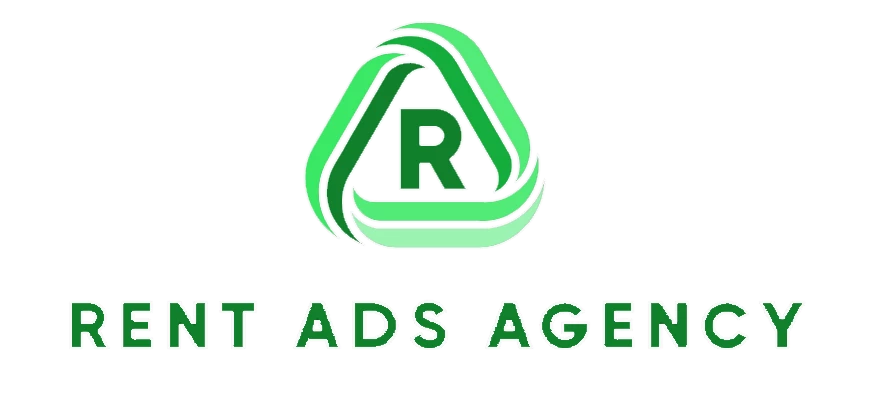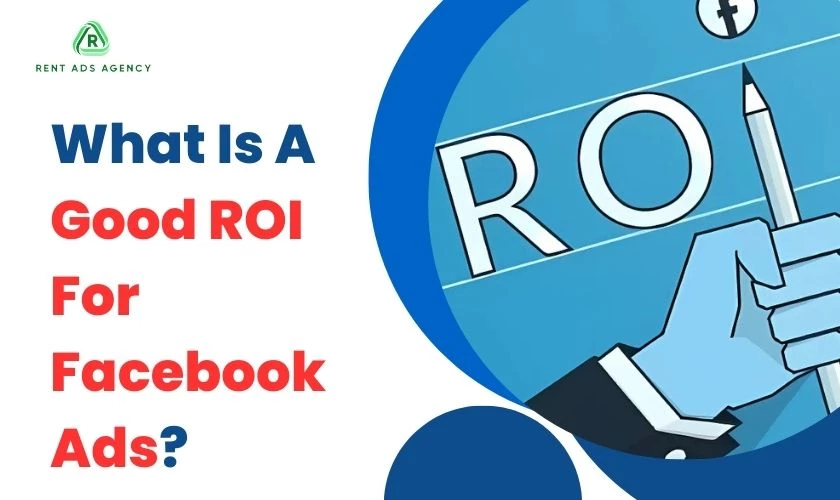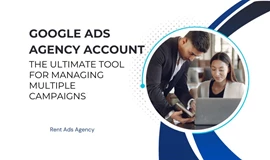To evaluate whether a campaign is truly effective and meets the original business goals, measuring the campaign's performance and impact is extremely necessary. In which, that person mentioned a lot about ROI - an index that helps businesses analyze the effectiveness of their investment for each specific campaign. So what is a good ROI for Facebook ads? How to measure the ROI index How does the communication process on digital platforms take place? Let's find out with Rent Ads Agency through the article below!
What Is ROI?
ROI (Return on Investment) means return on investment, return on investment or also known as the profit rate. This is an index that helps businesses measure the performance or profit earned from an initial investment.
The basic formula for calculating ROI is:
ROI = Net Profit/Cost of Investment ×100
For example, if a Facebook ad campaign costs $100 to run and generates $200 in sales, the ROI would be (200-100)/100 = 100%. The higher the ROI percentage, the better in terms of profits made versus money spent.
ROI can be used to determine if Facebook ads are worthwhile for meeting business goals like increasing sales and revenue, acquiring more customers, improving brand awareness and positioning the company for future growth or sales. Tracking ROI over time shows whether changes in ad targeting, creative or budgets are improving or worsening campaign performance. ROI data guides decisions about where to allocate Facebook ad dollars for optimal returns.
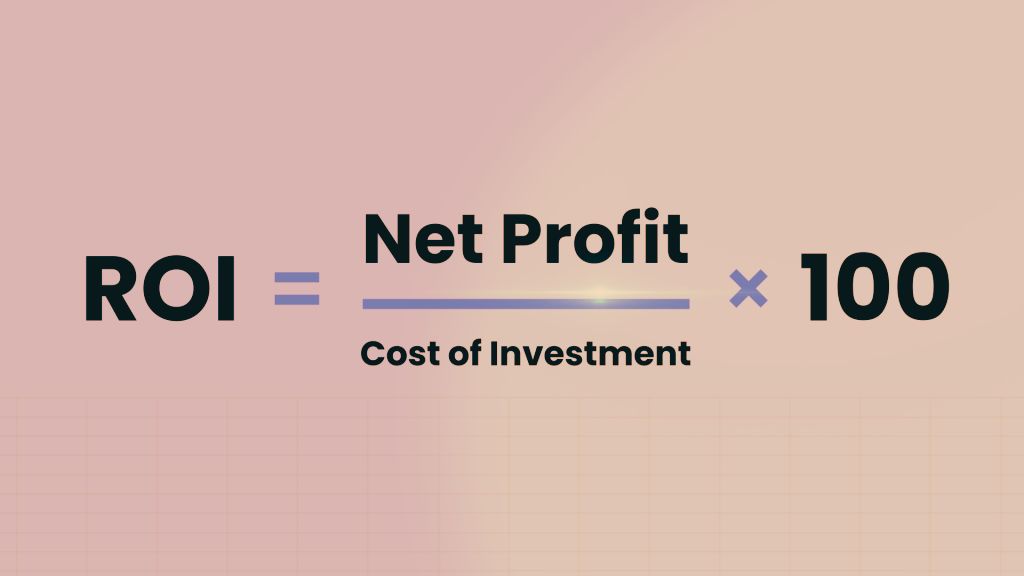
What is a Good ROI for Facebook Ads?
A good RoI is really dependent on the business model and the location it serves more than anything - there's not a standard (for Facebook, AdWords, etc.) for everything since each company is different. However, to give a specific number of what is good RoI for Facebook Ads, most marketers aim for 200-400%. This means for each $1 spent, $2 to $4 is made back in revenue.
| Industry | Typical ROI Range | Key Factors |
|---|---|---|
| Ecommerce | 200-500% | - Direct sales from Facebook ads - Higher AOV ($50+) increases ROI to higher range - Lower AOV ($15-30) may decrease ROI closer to 200-300% |
| SaaS | 50-200% | - Focus on lead generation rather than direct sales - Longer sales cycles require more nurturing, decreasing short-term returns - Smaller subscription order values ($10-50/month) lower ROI |
| B2B | 100-300% | - Wider variability depending on enterprise sales - Sales cycles over 6+ months require extensive lead nurturing, decreasing ROI - High 5-6 figure AOV deals offset longer cycles for 300% returns |
| Real Estate | 400%+ | - High-ticket property sales boost ROI - Granular audience targeting and custom audiences improve conversion rates - Faster sales cycles in entry-level real estate increase ROI viability |
Key Factors Across Verticals:
- Average order value (AOV)
- Sales cycle complexity/length
- Optimizing the marketing funnel and conversion process helps maximize ROI within industry constraints.
- Objectively setting ROI expectations and accurately tracking ROI is key.
Key Factors That Influence ROI on Facebook Ads
Successfully optimizing your Facebook ad spend relies heavily on understanding what drives higher returns. 5 main factors impact the ROI of your campaigns:
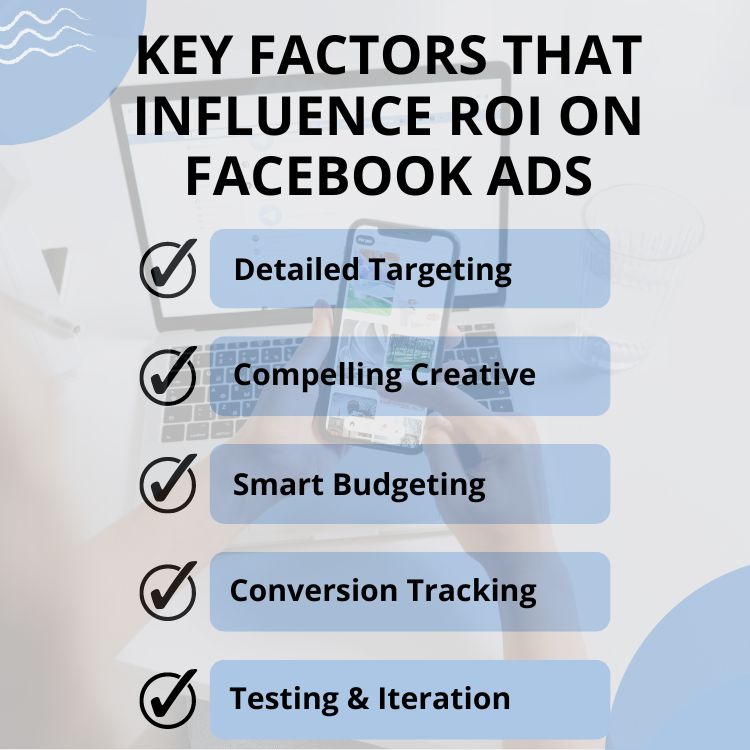
Detailed Targeting
Leveraging Facebook's vast trove of user data is key for relevance. Target interests like "online shopping" and behaviors such as "purchased women's shoes in the past 30 days" rather than just age and location. Connect offline data like emails and phone numbers to laser-focus your ads, ensuring that your targeting aligns with the Facebook ads KPIs that matter most.
Compelling Creative
Bright, emotional images and compelling ad copy lead to higher engagement and conversions. Test different headlines, image styles, and calls-to-action to see what resonates best with your audience. Align creatives to where customers are in the sales funnel.
Smart Budgeting
Allocate daily budgets to campaigns rather than ads to fully utilize Facebook's optimization capabilities. Start budgets lower, like $50 per day, and scale up high performing campaigns. Don't overspend on poorly performing placements.
Conversion Tracking
Install the Facebook pixel and integrate it with your CRM to track ROI accurately. Prove the revenue driven by paid social and uncover your best performing customer segments to further target similar users.
Testing & Iteration
Continuous AB testing of audiences, creatives, and placements is key for improvement. Build an agile process to launch new campaign variations and kill what doesn't work. Examine insights to understand the "why" behind high and low performing ads.
Closely monitoring these 5 factors provides the fuel for your campaigns to drive stronger returns on ad spend over time.
Tips for Improving ROI on Facebook Ads
If your current ROI isn’t meeting your expectations, don’t worry—there are plenty of strategies you can implement to improve it. Here are some proven tactics for maximizing your return on investment:
Continuously Test and Optimize Campaign Elements
Regularly A/B test different campaign elements including ad copy, imagery, videos, captions, calls-to-action, formats, placements and audiences. Leverage Facebook's built-in A/B testing tools to identify the optimal combination that delivers the highest click-through rates and conversion rates. Additionally, experimenting with the time to run Facebook ads can help identify when your audience is most active and receptive. Testing at least once a month ensures your ads are adjusted as audience preferences evolve.
Hyper-Target Your Audience
Create detailed buyer personas and tailor your ads and landing pages towards their priorities. Use Facebook's detailed targeting options to serve your ads to different segments under 100,000 users based on demographics, interests, behaviors and more. Keep custom audiences under 50,000 users for higher relevance and lower costs per click.
Implement Effective Retargeting Strategies
Create value-based lookalike audiences of 1%-3% of existing high-value customers to discover new customers with similar attributes. For lower-funnel retargeting campaigns, create 1% lookalike audiences based on visitors who added items to cart or filled out lead forms, but did not complete desired actions. Maintain frequency caps of 1-2 times daily to avoid oversaturating users.
Continually Measure and Analyze Metrics
Go beyond vanity metrics and track actionable metrics daily including click-through rates, cost per lead, conversions by audience and creative elements. Calculate ROI monthly, then make data-driven decisions to pause underperforming elements and increase investment in better performing ads/audiences. Over time, you can double down on what works and eliminate waste.
What are the alternatives to ROI?
While return on investment (ROI) is undoubtedly a popular metric, it doesn’t always capture the full picture. ROI calculations can overlook key factors like risk, time value of money, and qualitative impacts. Thankfully, many alternatives to ROI exist to address these limitations.
Net Present Value (NPV)
Net Present Value (NPV) calculates the current value of future cash flows minus the initial investment. It factors in the time value of money by applying a discount rate, usually the cost of capital or minimum acceptable rate of return.
For example, a $100,000 infrastructure project is expected to generate $30,000 in annual cash flows over 5 years. Using a 10% discount rate, the NPV is $75,615.
NPV is best for capital budgeting decisions on long-term investments. It helps determine whether large upfront investments will provide positive returns over time.
Internal Rate of Return (IRR)
Internal Rate of Return (IRR) is the annualized return rate that makes the net present value of an investment zero. It represents the maximum acceptable discount rate to break even on an investment.
For example, if a $50,000 project returns $15,000 annually for 5 years, the IRR is 14.5%.
IRR helps compare mutually exclusive projects allowing companies to select investments with the highest potential returns. It is commonly used in venture capital and private equity.
Annualized ROI
Annualized ROI measures the average growth rate per year rather than over the total investment horizon. It makes comparisons between short and long-term investments more equitable.
Formula:
Annualized ROI = (Final Value - Initial Value) / Initial Value x 100 / Number of Years
For a 3-year investment with a $30,000 initial cost and $45,000 terminal value, the annualized ROI is 15%.
This approach helps adjust ROI for time when benchmarking performance of assets like machinery or software across different useful lifecycles.
Social Return on Investment (SROI)
Social Return on Investment (SROI) is suitable for charities, non-profits and CSR initiatives focused on social and environmental impact.
It quantifies the approximate dollar value of non-financial outcomes like jobs, training opportunities and environmental benefits relative to resources invested.
For example, a recycling initiative could calculate the expected reduction of landfill waste and factor related savings into total SROI.
Marketing Return on Investment (MROI)
Marketing ROI measures incremental revenue directly attributable to marketing activities relative to spending.
Formula:
MROI = (Gains from Investment − Cost of Investment) / Cost of Investment
For a campaign with $100,000 in ad spending and $300,000 tracked revenue, MROI is 200%.
Analyzing marketing performance by channel helps optimize budget allocation to the tactics driving the highest returns.
Return on Ad Spend (ROAS)
Return on Ad Spend (ROAS) measures the revenue generated directly from advertising activities relative to ad costs across platforms like Google, Facebook, print, TV, etc.
It helps determine the profitability of an advertising campaign by revealing which platforms and campaigns deliver the highest rate of return on investment.
Formula:
ROAS = Revenue from Ads / Total Ad Spend
For example, a campaign with a $50,000 ad spend that drove $150,000 in tracked sales would have a ROAS of 300% ($150,000 revenue / $50,000 ad spend).
Analyzing ROAS by channel and campaign allows companies to optimize budgets by allocating more funds towards high performing platforms and cutting inefficient ad investments. It is a key metric used by marketers to demonstrate tangible returns from advertising campaigns.
Common Mistakes That Lower ROI on Facebook Ads
While there are many strategies for improving ROI, it’s equally important to avoid common pitfalls that can harm your results. Here are a few Facebook ad mistakes that can lower your ROI on your campaign:
Ad Fatigue From Overexposure
Bombarding the same audiences with identical creatives leads to a saturation point where engagement falls drastically. Refresh ad copy, visuals, offers and audiences at least every 3-4 weeks. Analyze frequency metrics and limit each user to 2 impressions daily at most. Expand your reach with additional lookalike audiences and interests over time.
Not Closely Monitoring Metrics
Analyze metrics like click-through rate, cost per conversion, conversion rate, relevance score and ROI regularly instead of relying on vanity metrics like impressions and reach. Review reports frequently to catch issues early and capitalize on top performing assets before performance drops off.
Choosing the Wrong Campaign Objective
If your goal is sales, choose the conversions objective. If you just want traffic or impressions, choose accordingly. Matching campaign goals with objective signals Facebook what results you want so their algorithm can optimize delivery and find people more likely to complete your desired action.
Poor Audience Targeting
Avoid stuffing too many targets into one ad set. Separate different audience types into different ad sets for easier management and analysis. Go broad with interests under 20 million users and use lookalikes sparingly to maintain relevance. Let the algorithm optimize for people likely to convert based on performance history.
Weak Ad Copy
Ensure your ad copy clearly explains your value proposition and incites your ideal customer to act. Ad copy should be under 125 characters if possible and include a strong call to action. Write to your audience and include messaging that showcases tangible value. Test copy variations regularly.
Conclusion: Achieving a Good ROI for Facebook Ads
What qualifies as a “good” ROI varies widely by factors like business type and campaign strategy. Although 200-400% is a typical goal, optimizing through testing and tracking analytics matters more. Work to cut unprofitable ads, improve targeting, refresh creatives, then analyze monthly. If managing complex campaigns in-house becomes impractical, leveraging an ad agency like RentAdsAgency can maximize returns through expertise. We provide a Facebook agency account for rent service to help you scale your campaign strongly. With the right strategic approach, your Facebook ads can achieve your revenue goals cost-effectively.

Mohamed Fouad is a full-stack web developer and an entrepreneur who's really into advertising. He is the CEO of Rent Ads Agency, a company that helps businesses reach more customers through advertising. He graduated from Stanford University in 2018 and has over 4 years of experience in the tech industry.
